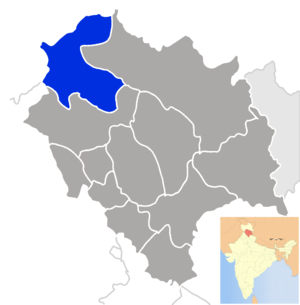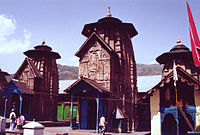- Chamba district
-
This article is about the district. For its eponymous headquarters, see Chamba, Himachal Pradesh.
Chamba district
Location of Chamba district in Himachal PradeshState Himachal Pradesh,  India
IndiaHeadquarters Chamba, Himachal Pradesh Area 6,528 km2 (2,520 sq mi) Population 393,386 (2001) Population density 60.26 /km2 (156.1 /sq mi) Official website Chamba is the northwestern district of Himachal Pradesh, in India, with its headquarters in Chamba town. The towns of Dalhousie and Khajjhiar are popular hill stations and vacation spots for the people from the plains of northern India. Chamba is the only state in northern India to preserve a well-documented history from circa 500 A.D. Its high mountain ranges have given it a sheltered position and helped in preserving its centuries old relics and numerous inscriptions. The temples erected by rajas of Chamba more than a thousand years age continue to be under worship and the land grant-deeds executed on copper plates by them continue to be valid under the law.
Regarding the early history of this region it is believed that this area was at time inhabited by certain Kolian tribes,which were later, subjugated by the Khasas. The Khasas too after a time came under the sway of Audumbaras (2nd centaury B.C.). The Audmabaras had republican form of government and worshiped Shiva as their principal deity. From the Gupta period (4th Centaury A.D.) the Chamba region was under the control of Thakurs and Ranas who considered themselves superior to the low tribes of Kolis and Khasas. With the rise of Gurjara Pratiharas (7th Centaury A.D.) the Rajput Dynasties came to power. Much information about Himachal’s ancient history is given in epics like the Mahabharata and the Ramayana and other scriptures like the Vedas and the Puranas. The Mahabharata mentions the janapadas (some sort of a kingdom) of Kuluta (Kullu), Trigarta (Kangra), Kulind (Shimla hills and Sirmaur), Yugandhar (Bilaspur and Nalagarh), Gobdika (Chamba) and Audumbar (Pathankot).
The Rig Veda mentions the rivers which flow through Himachal. The text also talks about Shambar, the powerful king of these hills before the advent of the Aryans, and his 99 strong forts in the region between the Beas and the Yamuna rivers. His war with the Aryan chief, Divodas, lasted 12 long years, wherein the latter emerged victorious. The Puranas too, mention Himachal, calling it all sorts of nice names.
One significant happening during the time of the great war of Mahabharata (circa 1400BC) was the founding of the Katoch monarchy of Kangra by King Susharma Chandra. This Susharma Chandra is supposed to have sided with the Kaurava borthers in their war against the Pandavas. Kangra was probably named as Bhim Kot (fort of Bhim) after Bhima, one of the Pandavas.
Contents
Economy
In 2006 the Ministry of Panchayati Raj named Chamba one of the country's 250 most backward districts (out of a total of 640).[1] It is one of the two districts in Himachal Pradesh currently receiving funds from the Backward Regions Grant Fund Programme (BRGF).[1]
Demographics
According to the 2011 census Chamba district has a population of 518,844,[2] roughly equal to the nation of Cape Verde.[3] This gives it a ranking of 544th in India (out of a total of 640).[2] The district has a population density of 80 inhabitants per square kilometre (210 /sq mi) .[2] Its population growth rate over the decade 2001-2011 was 12.58 %.[2] Chamba has a sex ratio of 989 females for every 1000 males,[2] and a literacy rate of 73.19 %.[2]
Languages
Languages include Bhattiyali, a Dogri-Kangri tongue spoken by at least 100 000 people in Chamba district.[4]
Interesing places
Laxmi Narayan Temple : It is the most famous tourist attraction place in Chamba. There are six temples dedicated to Lord Shiva and Lord Vishnu.Three temples are dedicated to Lord Vishnu, and another three to Lord Shiva.
Brajeshwari Devi Temple : This is the temple dedicated to goddess Durga and is famous for the fine carved sculptures. The style which makes the temple different from others is the shikara style and in top there is a wooden amalaka.
Chamunda Devi Temple : This is one of the famous temples in this quieenee valley,The Chamunda Devi temple is dedicated to goddess Chamunda,the wrathful form of Durga.One can find the fine wood carved ceiling featuring animal and floral motifs . This temple is located in the hilltop and gives a clear view of the Chamba valley .The devoties offer little brass bells to get their wish fulfilled.footprints of the Goddess is one more thing one can see.
Sui Mata Temple : The sui mata temple is in between the Chamunda Devi temple and Brajeswari temple. This temple is dedicated to Sui Mata, the local princess of Chamba who sacrifice her life for the people of her kingdom.Colourful paintings on the temple wall depicts the story of SuiMata.
Gandhi Gate : The Viceroy of British Government Lord Curzon had got a warm welcome by a bright orange gateway built in 1900 . It is the main gatway of Chamba.
Bhuri Singh Museum : The museum houses a vast number of original Pahari art and sculptures. Some notable collections include Basohli and Kangra paintings from the 18th and 19th centuries, as well as, a collection of Rumāls from the 7th century onward.
Salooni : 56 Km from Chamba is place of great natural beauty.
See also
- Fair and Festivals :
Chamba is famous for its vivid festivals. The Sui Mata festival is held for four days in March/April every year in memory of princess Sui. She is known to have scrificed her life for the cause of her people,that is, the people of Chamba.
At the time of the harvest of the maize crop which is the main crop of this region the local people in order to show their happiness and to enjoy after a hard toil celebrate.the festival is named as Minjar festival.
- CHAURASI TEMPLE : Nestled on the bank of the river Ravi, Chamba town complete 1000 years of its existence. The town stands on a plateau on the right bank of the Ravi river valley between Dhauladhar and Zanskar ranges south of the inner Himalayas. This town was founded by Raja Sahil Varman in the beginning of 10th Century. In the genealogical rolls of the Chamba Rajas, a reference occurs of place, which was adorned with highly fragrant Champaka trees and guarded by Goddess Champavati.
The temple was built by Sahil Varman in the honour of his daughter Champavati who is worshipped as a goddess in Chamba.
This glorious journey of one thousand years is a rich repository a highly civilized, cultured and developed society which existed in the lap of Himalayas.
The unique architect of houses and temples, splendid wood and metal craft, world fame Chamba Rumal and Chappal and of course the exquisite pahari paintings are some salient features of this one thousand years young town.
The Chamba town has a number of temples, Palaces and stylised buildings. The striking objects of interest are the old temples which exhibit architectural beauty of design and execution.
Laxmi Narayana Temple, which is the main temple of Chamba town, was built by
Sahil Varman in the 10th century AD. There are several other temples within the complex.The temple of Radha Krishna, Shiva Temple of Chandergupta and Gauri Shankar Temple are among these.
The ancient temple of Vajreshwari is believed to be 1000 years old and is dedicated to Devi Vajreshwari-Goddess of lightning.
The Sui Mata temple can be divided into three parts which can physically spread apart.
The Hari Rai temple is dedicated to Lord Vishnu and dates back to 11th century. A yet another place of interest in Chamba town is the Bhuri Singh Museum at Chamba
which came into existence on 14 September 1908. It is named after Raja Bhuri Singh who ruled Chamba from 1904 to 1919.
Bhuri Singh donated his family collection of paintings to the museum. The embroidered Chamba-Rumals are related in style since
their drawings were made by pahari painters though the embroidery was done by the household ladies.
Reference of Chamba town would be incomplete without the majestic Chaugan. It is the heart and hub centre of all activities in Chamba.
Tradition is silent as to its use as a polo ground and the name is etymologically distinct from Chaugan, the Persian name of Polo, being of Sanskrit origin and meaning 'four-sided'.
Initially the five Chaugan were a single patch of meadow. To mark the completion of 1000 years of this town, the Government of Himachal Pradesh is celebrating
the millennium of this town from 14 to 20 April 2006 in a most befitting way. The celebrations would provide the people
the opportunity to have a first hand knowledge of the rich cultural and historical past of the Chamba town.Reference of Chamba town would be incomplete without the majestic Chaugan. It is the heart and hub centre of all activities in Chamba.
Tradition is silent as to its use as a polo ground and the name is etymologically distinct from Chaugan, the Persian name of Polo, being of Sanskrit origin and meaning 'four-sided'.
Initially the five Chaugan were a single patch of meadow. To mark the completion of 1000 years of this town, the Government of Himachal Pradesh is celebrating
the millennium of this town from 14 to 20 April 2006 in a most befitting way. The celebrations would provide the people
the opportunity to have a first hand knowledge of the rich cultural and historical past of the Chamba town.References
- ^ a b Ministry of Panchayati Raj (September 8, 2009). "A Note on the Backward Regions Grant Fund Programme". National Institute of Rural Development. http://www.nird.org.in/brgf/doc/brgf_BackgroundNote.pdf. Retrieved September 27, 2011.
- ^ a b c d e f "District Census 2011". Census2011.co.in. 2011. http://www.census2011.co.in/district.php. Retrieved 2011-09-30.
- ^ US Directorate of Intelligence. "Country Comparison:Population". https://www.cia.gov/library/publications/the-world-factbook/rankorder/2119rank.html. Retrieved 2011-10-01. "Cape Verde 516,100 July 2011 est."
- ^ M. Paul Lewis, ed (2009). "Bhattiyali: A language of India". Ethnologue: Languages of the World (16th edition ed.). Dallas, Texas: SIL International. http://www.ethnologue.com/show_language.asp?code=bht. Retrieved 2011-09-28.
External links

Doda district, jammu and kashmir Kishtwar district, jammu and kashmir 
Kathua district, jammu and kashmir 
Lahaul and Spiti district  Chamba district
Chamba district 

Gurdaspur district, Punjab Kangra district Districts of Himachal Pradesh Geography of Himachal Pradesh Lakes 
Rivers Districts Other ====
Categories:- Himachal Pradesh
- Districts of Himachal Pradesh
- Hill stations in India
- Chamba district
Wikimedia Foundation. 2010.


